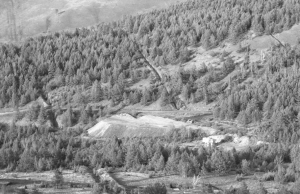Two months after China banned foreign ownership in tungsten and molybdenum mines, Mongolia has given QGX (QGX-T, QGXLF-O) the green light to move forward with an open-pit mine at its tungsten-molybdenum project at UndurTsagaan.
Given that China produces about 80% of the world’s tungsten and looks poised to restrict further exports of the commodity, that puts QGX in a good strategic position, says Paul Zweng, QGX’s president and CEO.
“China is moving towards becoming a quasi-monopolist regarding the sale and distribution of steel products that have been hardened by tungsten — like cutting steel — with the idea that it will command a higher price,” Zweng says.
“They’re slowing, if not outright stopping, the exportation of tungsten into the global marketplace. That is going to put the spotlight on projects outside of China and QGX has the largest tungsten project in Mongolia.”
On Oct. 31, China’s Ministry of Commerce and the National Development and Reform Commission issued new rules for foreign investors.
Under the rules, which went into effect on Dec. 1, China has reclassified tungsten, molybdenum, tin, antimony and fluorite into the “forbidden category” from the “restricted category” for foreign investors.
The rules also mandate that only Chinese can hold a majority stake in exploration and mining of spe- cialty coal, such as coking coal.
While the legislation may have distressed foreign investors like Silvercorp Metals (SVM-T, SVMFF-O), which was forced to abandon its Ying moly project in June, it’s been advantageous to companies like QGX.
“We think Undur Tsagaan will be an attractive asset for Japanese, Korean, and Russian groups that continue to need tungsten and are concerned that they may be unable to obtain it from China like they have in the past,” Zweng says. “There aren’t that many tungsten projects outside of China.”
Tungsten is an industrial metal primarily used to harden steel. It can also be used in a wide variety of applications from jet turbine engines and high-speed cutting tools to electronic circuitry and surgical instruments.
Russian and Mongolian teams first explored Undur Tsagaan in the late 1970s and early 1980s. They drilled about 60 holes and a total of 14,900 metres. At least two drill holes penetrated mineralization at a depth of 600 to 650 metres.
In addition to the drilling, numerous pits, trenches, and adits were dug to explore the prospect. Based on those results, Undur Tsagaan was reported in 1982 to have a resource of 141 million metric tonnes at 0.124% tungsten trioxide, 0.019% molybdenum, 0.03% beryllium and 0.08% bismuth in the C1 and C2 categories, plus 60 million tonnes at 0.11% tungsten trioxide, 0.03% molybdenum, 0.03% beryllium and 0.01% bismuth in the P1 category.
Under the Russian system for classification of reserves and resources, C1 is the equivalent of proven or probable reserves or indicated resources; C2 is a probable reserve or indicated/inferred resource; and P1 is inferred.
QGX’s mining lease for Undur Tsagaan, about 300 km east of Ulaanbaatar, is good for 30 years and can be renewed twice, for a 20-year period each time.
A feasibility study must be done on the project, which realistically won’t move into production until 2011 or 2012, Zweng says.
In order to receive a licence, QGX submitted a geological report with a resource calculation, an environmental baseline study, a hydrology study, and a geotechnical study to the Minerals Council in November. Its reserve was registered at the end of December and its licence granted in February.
Despite the prevailing unease among foreign investors about Mongolia’s approach to mining and the future of projects there following the imposition of a windfall profits tax in 2006, as well as delays in approving an investment agreement with Ivanhoe Mines (IVN-T, IVN-N) on its massive Oyu Tolgoi project, Zweng says getting the mining licence was straightforward and that it will provide greater certainty of rights under the mining law.
“I think the tendency is for people to react overly negative when they first learn about mining law initiatives taking place in third-world countries,” he says. “Instead, they need to consider what is happening in the more developed nations regarding mining law so that the initiatives can be placed into context.”
As evidence, Zweng points to the current law banning the use of cyanide in Montana for gold mining, the recent increase in oil royalties by the Alberta government, and the effective nationalization of the Windy Craggy copper- cobalt project in British Columbia some years ago. In addition, he points out, the U.S. is now contemplating the enactment of an 8% royalty on gross mining revenue.
“Changes to mining laws in favour of the host jurisdiction are occurring globally and we in the mining industry need to be prepared to develop win-win solutions to these circumstances.”
As far as Mongolia is concerned, Zweng says he is convinced that Ivanhoe’s OT investment agreement will go through because people in Mongolia want mining.
“They want the taxes and jobs that it will generate,” he says. “It’s just a question of timing. Politicians aren’t going to rush to a hasty judgment. . . They want to get it right and building a consensus takes time.”
QGX shares have a 52-week trading range of $1.95-4.15. The company has about 47 million shares outstanding.


Be the first to comment on "QGX nails mining licence in Mongolia"